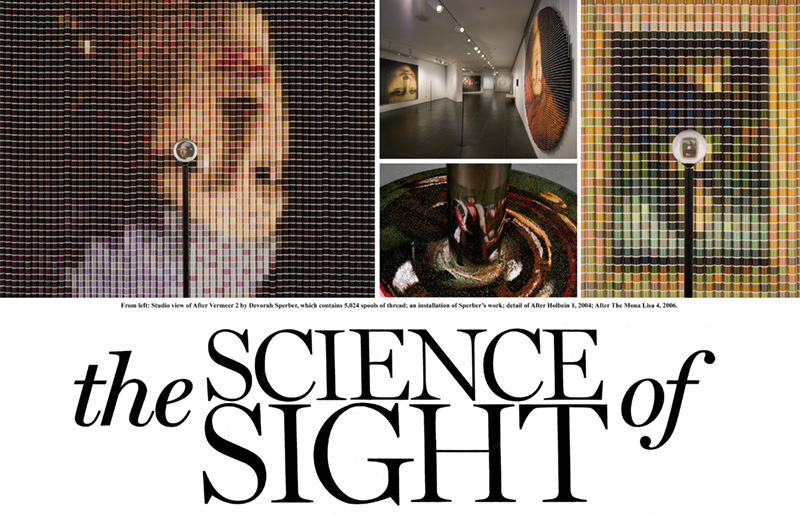
The science of sight National Post Published: Thursday, October 11, 2007 There are hundreds of university courses that can teach us how to look at art, but there are just a couple that will teach us how we actually see it. New York artist Devorah Sperber, who makes her Canadian premiere in Ottawa today, creates double-take-worthy sculptures that bridge art history and optical neurology. Speaking from her Woodstock, N.Y., studio with Leah Sandals, Sperber focuses on the origins of her art, and colours its expansive scope.
Q You had a big show at the Brooklyn Museum this spring, with great reviews in The New York Times and The New Yorker. What will we see in Ottawa?
A The works on display in Brooklyn and Ottawa come from a 2004 New York show on links between art, science and technology through the ages. The Ottawa work is based on a painting called The Ambassadors by Holbein. I've turned the painting into an anamorphic circular rug with a cylinder revealing the original image. The reason I did that is there's this anamorphic skull in The Ambassadors that you can only see from a certain physical position. Anamorphic perspective was a technology painters used then; using digital technology today to create the rug pattern, and a similar effect, joins past and the present.
Q Do viewers have to know all those art and science references?
A No. My goal is to create a direct visual experience that you don't need to read a wall text to get. Initially when you see this work, it looks like a carpet of swirling greens, reds and pinks. And then you see the cylinder and the image emerges. And you think, wow, there's something in that abstraction; that's the direct part. All my works address how the human brain makes sense of the visual world. We like to think what's coming in through our eyes is the real world, but it's really raw data that's taken in through the brain and processed into a picture of the universe.
Q How did you get interested in the science of seeing?
A It started with a comment from Douglas Kass, a neurological scientist. He used the term "neurological priming" while visiting my studio. This term refers to how your brain is primed to see certain images, like the Mona Lisa or The Ambassadors, through repetition. I thought, that's what's making people go "wow" when they see my work. In the Netherlands they say "wow," in Japan they say "wow." I even yelled "wow" when I stumbled on my work!
Q Stumbled on the work?
A I started to use optical devices by chance. I was creating my first thread spool work, a really large work in a very small studio. I couldn't see it in its entirety even from the hall. There were binoculars lying around and I flipped them around, using them the wrong way, to see the whole thing. When I did that, the abstract thread spools changed into a realist image again.
Q And how did you start making thread spool copies of well-known paintings?
A It goes back to when the slides artists used to document artworks were being transferred to digital formats. I remember seeing my work on a monitor for the first time and going, "Oh my gosh, what does this mean?" How does an artist, especially a sculptor, deal with digital nothingness? Because a sculptor deals with space, volume and materials. Using thread spools, objects that could make 2-D images but also exist in 3-D space, was the result.
Q How else do you deal with digital technology?
A Well, I use computers to make templates for my work. But I want to balance that speed of digital with its opposite. So the best day in the world for me is when I'm assembling, putting thread spools on a grid or pipe cleaners into a rug pattern. It's slow; I'm taking the speed and turning it into something meditative. Also, I think a lot of digital art doesn't connect with viewers because it lacks the humanity of real objects in the real space we live in. My use of materials that people can relate to -- thread spools, pipe cleaners --helps with that connection. Because my intent is not just to reach the artgoing audience. The non-artgoing audience is very important to me; that's my history. I come from immigrant parents. We never went to museums; all of this is really self-taught. So I wouldn't want to lose who I would be had I not stumbled upon art. I wouldn't want the alternate version of me not to like the work.
Devorah Sperber plans to attend her show opening today from 6 to 8 p.m. at the Ottawa School of Art Gallery, 35 George St., Ottawa. For details, visitwww.artottawa.ca. Sperber's show runs to Nov. 18.